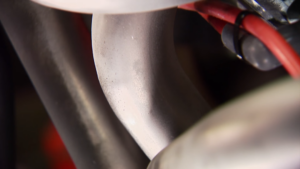In my years of working on motorcycles, I’ve come to recognize the importance of choosing the right paint for customizing a motorcycle’s exhaust. Trust me, it’s not something you can gloss over with regular paint; you need something more resilient to the heat.
You might wonder why this matters. Well, with exhausts, engines, and other surfaces on motorcycles that tend to get quite hot, specific paints are required, ones that are made just for these unique conditions.
Allow me to share my top pick with you: PJ1’s Engine and Case Paint. This is not just something I stumbled upon; this choice comes from over a decade of hands-on experience with motorcycle exhaust paints. Having tested many options in the long term, PJ1’s offering stood out. It gives you a shiny black look, letting you match your aftermarket exhaust to a black engine cover. Trust me on this; I’ve seen many paints in my time, but the finish on this one can hold up to extremely high temperatures and doesn’t scratch as quickly as others.
But that’s just the beginning. I have more thoughts and recommendations on the best paints for your motorcycle exhaust, gleaned from years of hands-on experience and experimentation. If you’re as passionate about your ride as I am, keep reading to learn more. You won’t regret making the right choice for your bike, and I’m here to guide you through it.
Overall Best
PJ1 Engine And Case Paint
PJ1’s Engine and Case Paint caught my eye when I was looking for something to give my bike’s exhaust and engine a cool black look. Having worked with various types of paint before, I was intrigued by its unique formula that claims to become tougher as you ride your bike, with a smooth finish that’s less prone to scratching.
After giving it a try, I was genuinely surprised by its heavy-duty design. This paint is no joke; it can withstand just over 500 F or around 260 C. If you’re like me and love to customize your motorcycle exhaust, you’ll find that this paint can hold up to those extremely high temperatures.
What does that mean in practice? Well, 500 F is plenty for the muffler, mid-pipe, and even the header pipes on all but the most high-performance motorcycles. PJ1 says it’s suitable for all 4-stroke and 2-stroke bikes. From my perspective, though, I’d caution against using it with header pipes on some 2-stroke bikes. These can get hotter than average, and I wouldn’t want to see the paint degrade over time. But for most other applications? It does the job just fine.
I experimented with it on the exhaust, engine cases, cylinders, and heads, and I didn’t have to worry about the paint fading or cracking. Applying the paint was a breeze. True to PJ1’s boast of a quick, one-step process, I found it just as simple. It comes in aerosol form, so all I had to do was spray a prepared surface, and there it was—a completely blacked-out motorcycle exhaust.
I found that I might need multiple coats to get the exact look I wanted, but the paint itself is a deep and glossy black. Though I usually prefer a chrome motorcycle exhaust, the gloss black of this paint almost won me over!
The finish was smooth and glossy, with a distinct sheen that looked amazing. I loved that PJ1’s paint is heat-treated, so it cures with the heat of regular motorcycle riding, adding to the durability.
Durability? Let me tell you about that. This paint has a thick outer layer that seemed to refuse to scratch! I tried it out on my dirt bike’s exhaust, took it off-roading, and exposed it to mud, rocks, and even a nasty spill. No scratches at all.
When I got back home, cleaning it was a snap. Just some soap and water, and the paint was back to its former glory. If you’re considering a change to your motorcycle’s exhaust or engine, this is one option I can wholeheartedly recommend from my hands-on experience.
Pros
- Slick black finish
- Durable outer coating
- Resists scratching and chipping
- Can withstand up to 500 F or 260 C
- Ideal for motorcycle exhausts
- Works with 4-stroke and 2-stroke engines
- Easy application
- Cures with the heat of regular riding
- Easy to clean off dirt and grime
Cons
- May not be able to withstand the heat of some header pipes
Best Budget
JEGS Aluminum Color Exhaust Header Paint

When I stumbled upon JEGS motorcycle exhaust paint, I was intrigued by its budget-friendly price. It claimed to hold up to extremely high temperatures and offer a durable surface coating. The aluminum finish caught my eye, so I decided to give it a try.
First impressions? I liked this affordable motorcycle exhaust paint more than I thought I would. The aluminum finish, while not as flashy as gloss black, definitely had a charm of its own. It gave off a matte appearance that looked exactly like aluminum, and to my surprise, it didn’t fade or dull over time.
I’ve tried quite a few motorcycle exhaust paints, and this one stood out for its durability. It was scratch-resistant and didn’t chip or peel. JEGS promised a porcelain-like bond with metal at very high temperatures, so I was eager to put that claim to the test.
When it came to heat resistance, this affordable option gave some of the higher-priced paints a serious run for their money. It’s rated to withstand up to 1200 F or around 650 C, and I found that it lived up to that claim.
I went ahead and painted the mufflers, mid-pipes, header pipes, engine casings, and cylinder heads on my bike. The aerosol form made it easy to apply. A bit of light sanding beforehand worked wonders for the final result. Though tempted to use a primer, I followed JEGS’s advice against it and tested both ways. Trust me, sans primer is indeed the way to go.
After painting, the waiting game began. It needed about 2 hours to fully cure, and JEGS recommends doing it at 400 F or around 200 C. So, a couple of hours of riding the bike did the trick and fully cured the paint.
As I admired the color, I realized that it looked pretty nice. The aluminum finish also helped hide any existing scratches, dings, and discoloration on my aluminum exhaust. As long as the shade matched, I was good to go.
But how did it perform in the real world? I was impressed. The paint held up well to all kinds of abuse. Whether on-road or off, it seemed unfazed by small stones, road grime, mud, and water. That ‘porcelain-like bond’ seemed to be doing its job, indeed.
In conclusion, this budget-friendly option from JEGS exceeded my expectations. It proved to be more than just an economical choice, delivering quality and performance that made it a worthwhile addition to my motorcycle maintenance kit. If you’re considering a new look for your exhaust without breaking the bank, this paint might be just what you’re looking for.
Pros
- Aluminum finish
- Comes in aerosol form
- Matte finish
- Can cover up scratches, dings, etc on aluminum exhausts
- Finish doesn’t dull or fade over time
- More resistant to scratches and peeling
- Easy application
- No primer required
- Can withstand up to 1200 F or 650 C
- Ideal for even the hottest exhaust parts
- Cures at 400 F or 200 C
- Only needs 2 hours to cure fully
- Durable paint finish
- Budget-friendly
Cons
- Could look awkward if the paint doesn’t match perfectly
Premium Choice
VHT FLAMEPROOF Coating

I recently got my hands on VHT’s Flameproof paint for motorcycle exhausts, intrigued by its claim to withstand the hottest temperatures. Its standard black color promised to add a modern touch to my older bike, and its durability assured me that it wouldn’t fade over thousands of heat cycles.
From the outset, I knew I was investing in a premium product. It was a bit pricier than other options, but the quality spoke for itself. The flat black color profile transformed my motorcycle exhaust, giving it a powder-coated look that I couldn’t help but admire. It blended perfectly with my engine’s design and bestowed my bike with a stealthy black appearance.
However, not all was perfect. The only issue I encountered with this motorcycle exhaust paint, which is true for flat black paints in general, is that it made every bit of dust glaringly visible. Keeping my exhausts clean became a bit more challenging, but for the look it offered, I was willing to put in the extra effort.
Where this paint truly shined was in its heat resistance. It’s rated to withstand an unprecedented 1300 F to 2000 F or around 700 C to 1000 C! To put it simply, this paint was suitable for almost every surface on my motorcycle. I went to town on the mufflers, mid-pipes, header pipes, cylinder heads, engine cases – you name it, this paint worked wonders on them all. I even jokingly considered trying to paint the exhaust gases themselves, though I’d caution anyone against attempting that feat.
Durability was another strong suit of this paint. I didn’t have to deal with any flaky paint, discoloration, peeling, or any other annoyances. Taking my bike off-road was no concern either, as the unique abrasion-resistant formulation refused to scratch easily.
Applying the paint was a straightforward process, but like other high-temperature-resistant paints, it needed time to cure and fully bond to the metal. Thankfully, the curing process could be done on or off the bike, so I was free to apply the paint and ride as I normally would.
In conclusion, VHT’s Flameproof paint proved to be the absolute best choice for my motorcycle exhaust. It might have demanded a higher price, but the performance, appearance, and durability I experienced made it well worth the investment. If you’re looking to transform your motorcycle’s look and want something that can handle extreme conditions, this paint should be at the top of your list.
Pros
- Flat black color
- Does not scratch or peel off
- Holds up well to small rocks, road grime, etc
- Can withstand up to 2000 F or around 1000 C
- Can be used in exhausts, engines, etc
- Does not discolor or fade over time
- Can be cured while riding the bike
- Easy to apply
- Made in the USA
Cons
- Flat black is hard to keep clean






